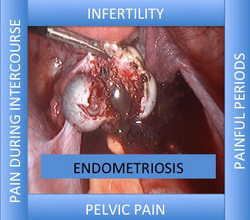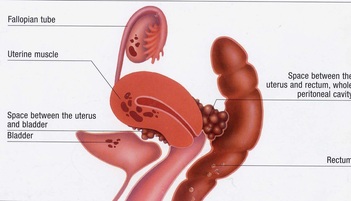
Endometriosis is a condition where cells that normally line the inside of the womb find themselves outside the womb. These cells can find themselves anywhere in the pelvis: on the bladder, on bowel, on the ovaries or on the ligaments that support the womb.
They can be found on the appendix and on occasion in any organ of the body.
How common is endometriosis?
Endometriosis affects between 5-10% of the general female population
In the United Kingdom about 2 million women of reproductive age suffer with endometriosis.
It is commoner in women who find it difficult to get pregnant and have children; it is also commoner in women who have painful periods.
It tends to run in families; about 10% of women who have endometriosis will have a family history of this condition.
What causes endometriosis?
No one knows exactly why some women have endometriosis and others do not.
A number of theories have been put forward to the possible causes. No single theory can explain the reason for endometriosis in all women who are diagnosed with it.
1. Spillage of cells through the fallopian tubes during periods.
During menstruation about 90% of women will have some spillage of menstrual cells through the fallopian tubes into the abdominal cavity (into the tummy). For most women the body absorbs these cells. In women who develop endometriosis it is thought that these cells are not entirely absorbed. The body then tries another way of protecting itself from these cells. In some women it forms adhesions to block these cells off from the rest of the body. This process may be due to altered immunity in some women.
2. Transport of menstrual cells through the blood stream
Some scientists believe that the cells travel through the blood to reach other organs of the body. They believe that this is why endometriosis can be found in organs far away from the pelvis
3. Normal cells can change into endometriosis cells
Other scientist thinks that we are born with cells that have the potential to transform themselves into other cells under certain conditions. And in certain women these cells are triggered by unknown mechanisms to become endometriosis cells
Symptoms of endometriosis:
Endometriosis is not cancer but can be responsible for a variety of symptoms, which include:
1. Pelvic pain
a. Pain during periods (cyclical pain)
b. Pain when not having a period (non cyclical pain)
c. Pain when opening bowels
This pain may be due to endometriosis on the bowel or endometriosis on the ligaments that support the womb.
Some women describe this type of pain as worse when they are having periods
d. Pain during sexual intercourse
e. Pain on emptying the bladder. This may be due to endometriosis on the bladder
The pain of endometriosis is often described as central lower abdominal pain that can radiate round to the lower back and down the legs
other symptoms include bladder symptoms like going to empty the bladder very often (frequency), or blood in faecal motions (in stool)
2. Infertility
There is a well-documented link between endometriosis and infertility.
Endometriosis can be responsible for fertility problems in up to 50% of women who have it. However things to note are:
1. The majority of women who have endometriosis will get pregnant with not problem and the pregnancy will be without problems.
2. Problems related to endometriosis depend sometimes on the stage of endometriosis
3. The more advanced the endometriosis the more fertility becomes and issue.









 RSS Feed
RSS Feed